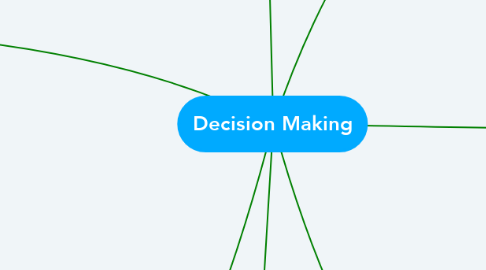
1. Introduction
1.1. Easier to make decisions with fewer alternatives.
1.2. More choice=less satisfaction with choice we made and harder to make the decision.
1.3. Decisions are made through framing.
1.4. Decisions need to be effective and efficient to have the outcome you want - Rational decision making.
1.5. Efficiency - Making a timely decision. Effectiveness - Making the right decision.
1.6. When we make a decision, we have to make another decision to implement that choice we made. (frog on the log)
2. Bad Decision Making
2.1. E.J Smith - Captain of Titanic. Didn't slow down.
2.2. Van Zenten - KLM Pilot. Plane was redirected to Tenerife. Bad weather when taking off. Didn't get clearance from tower.
2.3. Eastern Airline - Faulty part when landing. Focused on intelligence stage, didn't realize auto pilot turned off. Plane crashed.
2.4. Tragedies caused by bad decisions.
3. Structure of Decision Making
3.1. 1. Intelligence - Identifying your problem.
3.2. 2. Design - Search for alternatives.
3.3. 3. Choice - Choosing an alternative to follow (solution).
3.4. Herbert Simon
4. Complexity of Decision Making
4.1. Volume/Velocity/Variety of data
4.2. Time Pressure
4.3. Uncertainty
4.4. Remote Inputs
4.5. Knock-on Impacts
4.6. No. of alternatives
4.7. Optimisation
4.8. Dynamic
5. Gorry and Scott Morton
5.1. Different type of I.S systems for different decisions.
5.1.1. E.J Smith - Operational Control and Structured to Management Control and Semi-structured. He let managerial concerns impact his decision
5.1.2. Van Zenten - Operational Control and Structured to Management Control and Unstructured. Became a managerial issue (will his passengers get there in time)
5.2. DM Hierarchy of I.S
5.2.1. EIS - Executive Information System(system) - Executive(personnel) - Strategic(decision)
5.2.2. DSS - Decision Support System(system) - Managerial(personnel) - Tactical(decision)
5.2.3. TPS - Transaction Process System(system) - Operative(personnel) - Operational (decision)
6. Cynefin Framework
6.1. Definition
6.1.1. Helps to make good decisions when you are in a difficult situation. Use appropiate method for specific demand. (sense making model)
6.1.2. Sense making model - Framework emerges from the data
6.1.3. Categorization Model - Data emerges from the framework
6.2. 1. Unpredictable
6.2.1. a). Complex: Cause & Effect only obvious in hindsight. Prob - Sense - Respond. Emergant practice
6.2.2. b). Chaotic: No cause & effect relationship. Act - Sense - Respond. Novel practice.
6.3. 2. Predictable
6.3.1. a). Complicated: Cause & Effect are self-evident, require expertise. Sense - Analyse - Respond. Good Practice.
6.3.2. b). Simple: Cause & Effect relationship is predictable and repeatable. Sense - Categorize - Respond. Best practice.
6.4. 3. Disorder
6.4.1. Not knowing which domain you are in. Intemperate situation to personal preference or action.
6.5. 4. Complacent
6.5.1. Between chaotic and simple.
6.6. Example - Air France Flight 447
6.6.1. Bad weather. Auto pilot dis-functions. Least experience pilot flying. Pulls back joy stick. Plane into ascent. Falls into ocean. >200 dead. Flying should be predictable, he made it unpredictable. simple - chaotic. No time to react.
7. Conclusion
7.1. Paradox of choice - Barry Schwartz
7.1.1. "absence of a metaphorical fishbowl is a recipe for disaster".
7.1.1.1. Fishbowl - Cockpit. This is all you need to know to fly a plane. Easier to make decisions.
7.1.1.2. Ocean - Tinder/Netflix. Impossible to know everything. Difficult to make decisions.
7.1.2. "Everything was better back when everything was worse"
7.1.2.1. Everyone needs a fishbowl. Satisfactory with decisions we make because not too many choices.
7.1.2.2. If we live in an ocean. No satisfaction with decision we make because too many choices.
